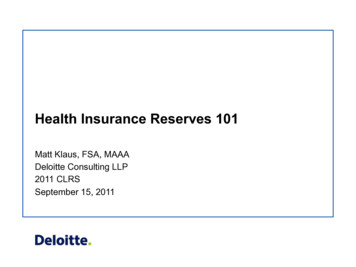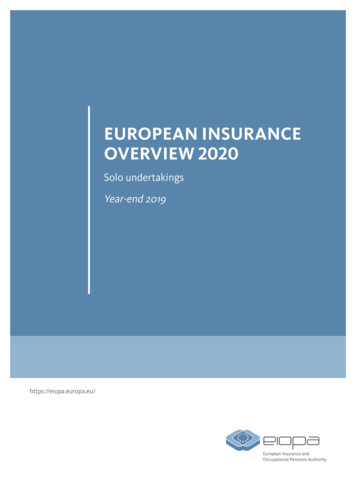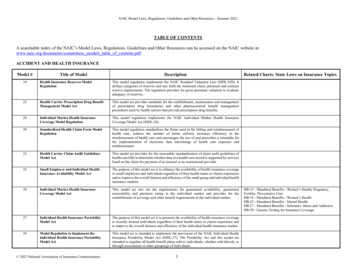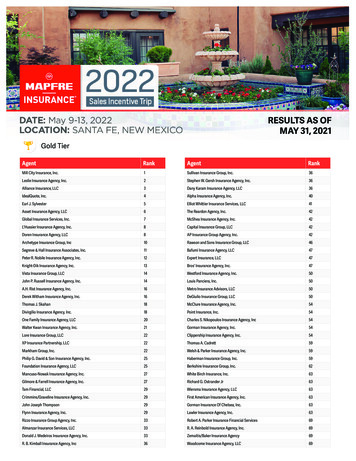
Transcription
Health Insurance Reserves 101Matt Klaus, FSA, MAAADeloitte Consulting LLP2011 CLRSSeptember 15, 2011
AgendaAccounting Bases and Accounting Guidance HierarchyOverview of ReservesClaim Reserves and LiabilitiesContract ReservesDeferred Acquisition CostsBenefit Reserves and DAC – Profit Recognition Under GAAPPremium ReservesReserve Adequacy
Accounting Bases and AccountingGuidance Hierarchy
GAAPStatutoryTaxPurposeMatch income andexpensesSolvencyDetermine taxableincomeFocusBest estimateConservatismTax revenueApplies ToAll public companiesInsurancecompaniesTaxpayingcompaniesUsers ofFinancialStatementsSEC, Wall StreetState regulators,rating agenciesIRSGoverningBodiesSEC, FASB, GASBStates, NAICIRS-4-Health Insurance Reserves 101.pptxAccounting Bases
Why does GAAP and Statutory Accounting Matter Now?¡ Principles-based accounting methods are likely coming in the future– GAAP will be moving to the International Financial Reporting Standards(IFRS)– Statutory will be moving to the Principles Based Approach (PBA)¡ However, GAAP and statutory accounting in current forms will still berelevant in near term and probably for a long time into the future– Public companies may still use GAAP for internal purposes after the adoptionof IFRS– Non-public companies may not adopt IFRS and stick with GAAP– Current proposed changes to statutory regulations apply PBA to Long-TermCare (LTC) but not yet to health products such as Individual Disability Income(IDI) and Group Long Term Disability (LTD)– Adoption of IFRS is not a certainty-5-Health Insurance Reserves 101.pptx– Tax reserves are generally based off of statutory amounts and IRS may notwant to move from the current rules-based statutory approach
GAAP Hierarchy¡ The Financial Accounting Standards Board (FASB) defines GAAPstandards for public companies (insurance and non-insurance)– Recognized as authoritative by SEC and The American Institute of CertifiedPublic Accountants (AICPA)– Key pronouncements include FAS 60 (insurance companies, now ASC944-20 through 944-60), FAS 106 (retirement benefits, now ASC 715-60),and FAS 112 (pre-retirement, post-employment benefits, now ASC 712-10)– Guidance provided by FASB via Interpretations and Technical Practice Aids(TPAs)– Other guidance is provided by sources such as AICPA (audit guides) andtextbooks (e.g. U.S. GAAP for Life Insurers)¡ The Governmental Accounting Standards Board (GASB) defines GAAPstandards for state and local governments-6-Health Insurance Reserves 101.pptx– Key pronouncement is GASB 45 (other post-employment benefits or OPEB)
Statutory HierarchyRegulations are proposed by the National Association of InsuranceCommissioners (NAIC) and adopted by the states. State regulations takeprecedent, then the hierarchy is as follows:Level 1: Statements of Statutory Accounting Principles (SSAPs) andcertain GAAP reference materials adopted by NAICØ Provided in NAIC Accounting Procedures and Practices Manual (APPM)Ø Ø Key SSAPs include No. 54 (A&H reserves) and No. 55 (claim liabilities)Appendix A-010 of APPM includes health valuation regulationLevel 2: Interpretations (INTs) issued by the NAIC Emerging AccountingIssues Working Group (EAIWG)Level 3: NAIC Annual Statement Instructions and NAIC Purposes andProcedures of the Securities Valuation Office manualLevel 5: Additional GAAP reference materials not included in Level 1-7-Health Insurance Reserves 101.pptxLevel 4: Statutory Accounting Principles of Concepts
Tax HierarchyTax reserves are generally based on statutory reserves withmodifications. The tax references are as follows:¡ IRS Tax Code– Sections 803(a)(2) and 807(a) require a net decrease in reserves to beincluded as income– Sections 804(1) and 805(a)(2), together with Section 807(b), allow adeduction to income for a net increase in reserves– Tax reserve categories are defined in Sections 807(c)(1) through 807(c)(6)¡ IRS Handbook provided to IRS agents¡ Field Service Advice (FSA) provided to agents by IRS¡ Technical Advice (TA) provided to agents by IRS¡ U.S. Tax Reserves for Life Insurers textbook-8-Health Insurance Reserves 101.pptx¡ Court rulings
Overview of Reserves
Reserve Categories¡ Contract Reserves¡ Unamortized Deferred Acquisition Costs (DAC)– Held as an asset¡ Claim Reserves– Incurred But Not Reported (IBNR)– Disabled Life Reserves (DLR)– Due and Unpaid– In Course of Settlement (ICOS)– Resisted claims¡ Premium Reserves– Unearned Premium Reserves– Deferred Premiums (held as an asset)- 10 -Health Insurance Reserves 101.pptx– Advance Premium– Due and Unpaid Premium (held as an asset)
Need for Reserves¡ Reserves are needed to pay claims in the future when premiums arereceived prior to the insured event¡ Required as part of GAAP and statutory accounting¡ The development of reserves impacts the emergence of profit– Under GAAP accounting, the objective is to realize profit as level percentageof gross premiums- 11 -Health Insurance Reserves 101.pptx¡ Claim reserves are used to recognize the loss in the period it wasincurred
Claim Reserves and Liabilities
Claim Reserves - Defined¡ The term “claim reserves” generally refers to claim reserves and claimliabilities¡ The statutory Annual Statement splits claim reserves and liabilities byexhibit:– Exhibit 6 – Claim Reserves Along with additional contract reserves, this exhibit includes Present Valueof Amounts Not Yet Due reserves (AKA disabled life reserves or DLR) PVANYD includes the “unaccrued” expected benefit payments due to thepolicyholder after the valuation date Includes claim reserves for incurred claims that are reported andunreported as of the valuation date– Exhibit 8 – Claim Liabilities Includes liabilities for incurred claims that are reported and unreported as ofthe valuation date- 13 -Health Insurance Reserves 101.pptx Includes liabilities for “accrued” benefit payments that are due to thepolicyholder as of the valuation date
Claim Reserves – Defined (continued)¡ Disabled Life Reserves– Reserves for expected future benefit payments on known open claims as ofthe valuation date¡ Incurred But Not Reported– Accounts for claims incurred prior to the valuation date that are unknown tothe insurer– For products such as IDI, LTD, and LTC, an IBNR claim includes an accruedliability (Exhibit 8) for services prior to the valuation date and an unaccruedliability (Exhibit 6) for services after the valuation date¡ Due and Unpaid– Reported claims adjudicated but payment not made as of the valuation date¡ In Course of Settlement (ICOS)¡ Resisted Claims– Claims in dispute at the valuation date- 14 -Health Insurance Reserves 101.pptx– Reported claims pending as of the valuation date
Disabled Life Reserves – Calculation¡ Generally calculated in a “tabular” fashion on a claim by claim basiswhere claim termination rate assumptions (i.e. probability of recovery)are looked up from stored tables– Tables typically vary by length of time the policyholder is disabled (i.e. claimduration) and characteristics of the policyholder (i.e. age at disablement), thepolicy (i.e. benefit period), or the disability (i.e. ICD9 codes)- 15 -Health Insurance Reserves 101.pptx¡ Interest rates vary by incurral year for statutory and it is common forinsurers to take the incurral year approach for GAAP
Disabled Life Reserves – Calculation Example¡ Assume a new disability claim has a 1,000 per year benefit¡ 5 year benefit period¡ Interest is 5% per year- 16 -Health Insurance Reserves 101.pptx¡ Claim termination rates (CTR) vary by claim duration
Disabled Life Reserves – Calculation Example 00.950.76 762215%0.680.910.62 617310%0.610.860.53 52945%0.580.820.48 47855%0.550.780.43 433Column (2)t Column (2)t-1 * [1-Column (1)t]Column (4) Column (2) * Column (3)Column (5) 1,000 * Column (4)- 17 -Health Insurance Reserves 101.pptxDisabled Life Reserve Sum of Column (5) 2,819
Disabled Life Reserves in Relation to Contract Reserves¡ Contract reserves are calculated using incurred claim costs– An incurred claim cost is the claim incidence rate times the DLR Assuming a 1% incidence rate and the DLR amount from the previousexample, the incurred claim cost would be 2,819 * 0.01 28¡ For policies in open claim status, a contract reserve is generallyrequired in addition to the disabled life reserve– Most morbidity tables are developed such that the exposure basis used forincidence rates is the total population (actives plus disableds)– Paragraph 34.c of appendix A-010 of the APPM states that “The contractreserve is in addition to claim reserves and premium reserves.” Incidence rates were developed based on active lives only Reserves account for expected claim costs for disabled lives that eventuallyrecover- 18 -Health Insurance Reserves 101.pptx– If a company releases contract reserves for open claims, it shoulddemonstrate that:
Disabled Life Reserves – GAAP Assumptions¡ Per paragraph 18 of FAS 60, claim reserves should be on a bestestimate basis without margin- 19 -Health Insurance Reserves 101.pptx– Paragraph 18 notes that adjustments can be made for inflation and “othersocietal and economic factors”– A strict interpretation of paragraph 18 would indicate that the best estimateinterest rate should be used for all incurral years at the valuation date, butcommon industry practice is to vary interest rates by incurral year
Disabled Life Reserves – Statutory Assumptions¡ Morbidity tables (i.e. claim termination rates) are prescribed and vary byproduct– IDI uses 1985 CIDA or 1985 CIDC Per appendix A-010 of APPM, have option to use 1985 CIDA for all openclaims or use 1985 CIDC for claims incurred 1/1/2002 and after and 1985CIDA for the rest Can use company experience for yearly durations 1-2 if experience credible– LTD uses 1987 CGDT Can use company experience in durations 1-2 if credible (also 3-5 withDepartment of Insurance approval)– Specified tables are “valuation tables” with margins over “experience tables”– No specified table for LTC– Products with additional contract reserves (e.g. IDI, LTC) use whole life rate– Products without additional contract reserves (e.g. LTD) use Single PremiumImmediate Annuity (SPIA) rate less 100 basis points- 20 -Health Insurance Reserves 101.pptx¡ Interest rates vary by incurral year
Incurred But Not Reported¡ Generally calculated using loss development methods– It is common to use paid claim data with incurred/paid dates instead ofincurred/reported dates, so that the reserve is really an Incurred But Not Paid(IBNP) reserve and ICOS is not necessary– Adjustments are typically made for recent incurral months without credibility Borhnheutter Ferguson method– Reserve for a given incurral year is equal to (1 - completion factor) times the ultimate incurredclaims as determined by an expected loss ratio– Products that require disabled life reserves, especially IDI and LTC, may haveIBNR calculated using a factor approach where a factor is multiplied by inforce premium at the valuation date to estimate the IBNR amount¡ The accrued portion of IBNR is generally not discounted- 21 -Health Insurance Reserves 101.pptx– For statutory, paragraph 8 of SSAP No. 55 indicates that no discounting isallowed
Other Claim Reserves and Liabilities¡ Due and Unpaid– Calculated based on an inventory of adjudicated but unpaid claims¡ In Course of Settlement– Calculated based on an inventory of reported but unapproved claims, withadjustments applied to account for probability of claims becoming approved¡ Resisted Claims– Calculated based on an inventory of disputed claims and the estimatedprobability that the claims will need to be paid by the insurer¡ Reopen Reserve- 22 -Health Insurance Reserves 101.pptx– Accounts for the likelihood of a closed disability claim to reopen later due tothe original cause of disability
Claim Expenses¡ Claim Expenses– Also known as Loss Adjustment Expenses (LAE)– Need to account for the future cost of adjudicating and paying claims– Usually calculated as percent of DLR or IBNR– For GAAP, must account for claim expenses per paragraph 20 of FAS 60– For statutory, must account for in accrued claim liabilities per paragraph 6.c.of SSAP No. 55- 23 -Health Insurance Reserves 101.pptx Does not seem that claim expenses are specifically required to be includedwith unaccrued claim reserves, but it is common in industry to do so
Contract Reserves
Contract Reserves - Defined¡ Also referred to as “policy reserves” or “active life reserves”– For GAAP, referred to as “benefit reserves”– For statutory, referred to as “additional contract reserves” Note that the statutory Annual Statement uses “active life reserves” tomean additional contract reserves plus unearned premium reserves¡ Contract reserves are typically required for individual health insuranceproducts with the following characteristics:– Premiums are level based on issue age (“issue age rated”), and– Claim costs are expected to increase over time (i.e. excess premiums in earlypolicy durations are used to “pre-fund” expected high claims at later durationsthat will exceed annual premiums)– Individual Disability Income (IDI)– Long-Term Care (LTC)– Specified Disease (AKA Critical Illness or Cancer)- 25 -Health Insurance Reserves 101.pptx¡ Contract reserves are generally required for the following products:
Contract Reserves – Defined (continued)¡ Individual health insurance products issued on an attained aged basis(versus issue age rated) typically do not require Contract reservesbecause premium rates increase in step with expected claim costs– Medicare Supplement business is generally issued on an attained aged basis However, some states require that Medicare Supplement be sold on anissue age rated basis, in which case contract reserves are needed¡ Group health insurance products typically do not require contractreserves because the business is usually renewed each year andpremiums are adjusted to account for the level of expected claims in agiven year- 26 -Health Insurance Reserves 101.pptx– Group LTC is an exception as it is issue age rated with level premiums For valuation purposes there is little difference between Individual andGroup LTC and the same types of reserves are held for both products
Contract Reserves – Calculation¡ The method used for Contract reserves depends on the accountingbasis– GAAP uses the net level premium method– Statutory generally uses the two-year full preliminary term (FPT) method,except for LTC which uses the one-year FPT method The mathematics between the GAAP method and the statutory methodsare the same except that no reserve is held in the first or the first andsecond policy durations under one-year and two-year (FPT)¡ Two approaches can be used to calculate contract reserves and theyproduce equivalent results- 27 -Health Insurance Reserves 101.pptx– Prospective– Retrospective
Contract Reserves – Calculation (continued)¡ The Prospective formula is as follows:Reserve PV of Future Benefits – PV of Future Net PremiumsorV PVFB ( x t ) PVFNP ( x t )t x Ax t NPx äx t¡ The Retrospective formula accumulates net premium less claim costs,based on assumptions for interest, mortality, and voluntary lapse:- 28 -Health Insurance Reserves 101.pptx(t 1Vx NPx ) (1 i ) CC x ttVx (1 t qxd ) (1 t qxw )
Contract Reserves – Calculation (continued)¡ The Net Premium is defined as the level amount of money needed eachyear to cover expected claims over the lifetime of the policy– The first step in calculating a contract reserve is to solve for the Net Premiumat time 0:0 Ax NPx äxAxNPx äx– Note that the actual premium paid by the policyholder (the gross premium)does not impact the contract reserve formula– For statutory, the Net Premium is solved for at either t 1 or t 2, dependingon whether the one-year FPT or two-year FPT method is applied- 29 -Health Insurance Reserves 101.pptx– Once the Net Premium has been solved for, the contract reserve can becalculated using the Prospective or Retrospective method and assumptionsfor interest, morbidity (claim costs), mortality, and voluntary lapse
Contract Reserves – Graphical Example¡ Contract reserves start at 0 and end at 0, and in between generallyincrease until claim costs exceed annual net premiums:Sample GAAP Contract Reserve by Policy Year 140,000 120,000 100,000 80,000 60,000 40,000 00510152025- 30 -30354045Health Insurance Reserves 101.pptx 20,000
Contract Reserves – GAAP Assumptions¡ For GAAP, the assumptions should be based on the company’s bestestimate during the year the policy was issued– Assumptions are “locked-in” at issue and do not change unless a premiumdeficiency exists– The benefit reserve should include Provisions for Adverse Deviations (PADs)as a level of margin¡ Non-deferrable policy and claim expenses must be accounted for perparagraph 21 of FAS 60– Only need to be included if expenses are not a level percent of grosspremium, otherwise no reserves are generated- 31 -Health Insurance Reserves 101.pptx– Typically expected claim expenses are a function of claim costs, meaning thata reserve is generated if claim costs increase by duration
Contract Reserves – Statutory Assumptions¡ For statutory, the assumptions are generally prescribed– The interest rate is the rate used for whole life insurance– Mortality table is generally the table used for whole life insurance LTC has specified tables depending on year of issue– Morbidity assumptions vary by product IDI generally uses the 1985 CIDA table but some companies in some statesmay also use the 1964 CDT table for some issue years LTC does not have a specified morbidity table Hospital Indemnity Plans (HIP) uses 1974 Medical Expense table; Canceruses 1985 Cancer table, ADB uses 1959 ADB table No voluntary lapses allowed for noncancellable insurance (typically IDI) LTC has restrictions on voluntary lapse rates that vary by issue year– No specific requirement to include policy/claim expenses in conract reserve– Specified tables are “valuation tables” with margin over “experience tables”- 32 -Health Insurance Reserves 101.pptx– Policy termination rates (mortality plus voluntary lapse) vary by product Restriction on policy termination rate for policies that are not noncancellable
Deferred Acquisition Costs
DAC - Defined¡ The term DAC in the context of GAAP accounting usually refers to the“intangible” DAC asset or Unamortized Deferred Acquisition Costs(UDAC)– DAC, in conjunction with the benefit reserve, allows for the realization of profitas a level percentage of gross premium, and is in line with the overarchingGAAP focus of matching income and expenses– Without DAC, companies would generally show a loss when issuing newbusiness due to the high costs of underwriting, first-year commissions, andmarketing– By setting up a DAC asset, upfront expenses are deferred until they can berecovered from future gross premiums¡ DAC does not exist in statutory accounting- 34 -Health Insurance Reserves 101.pptx– The one-year FPT and two-year FPT contract reserve methods are used toprovide some surplus relief from upfront expenses
DAC – Calculation¡ DAC is calculated in the same way that the benefit reserve is calculated,except the deferred expenses are substituted for the claim costs:DAC PV of Future Expense – PV of Future DAC Net PremiumstDAC x PVFE ( x t ) PVFDNP ( x t )¡ The DAC Net Premium is calculated at time 0 similar to how thebenefit reserve net premium is calculated:PVFExDNPx äx¡ The DAC formula produces a negative amount meaning that there is anegative reserve which is equivalent to an asset- 35 -Health Insurance Reserves 101.pptx¡ For a given policy, DAC is calculated using the same assumptions as tointerest, mortality, and voluntary lapse used for the benefit reserve
Benefit Reserves and DAC – Profit RecognitionUnder GAAP
GAAP Example - Details¡ A policy has a five year policy duration¡ Sold with level annual gross premium of 1,000¡ The insurance company incurs a 450 cost for underwriting and an 800 cost for commissions at policy issue for a total deferrable expenseof 1,250¡ Policy administration costs are expected to be a level 50 each year¡ The insurance company expects to pay 3,000 in total claims over thelife of the policy with claims varying by year as follows: 0 150 500 950 1,400¡ Assume no interest, no policy terminations, and no PADs- 37 -Health Insurance Reserves 101.pptxYear 1Year 2Year 3Year 4Year 5
GAAP Example – Contract Reserves by Policy Year¡ Calculate the Net Premium:NPx Ax 3,000 600äx5¡ Calculate contract reserves at each year end– For example, prospectively at end of year 2:V PVFB PVFNPReserve:Year 1Year 2Year 3Year 4Year 5 600 1,050 1,150 800 0- 38 -Health Insurance Reserves 101.pptxV ( 500 950 1,400) ( 600 3) 1,050
GAAP Example – Unamortized DAC by Policy Year¡ Calculate the DAC Net Premium:DNPx PVFEx 1,250 250äx5¡ Calculate unamortized DAC at each year end– For example, prospectively at end of year 2:DAC PVFE PVFDNPDAC:Year 1Year 2Year 3Year 4Year 5 1,000 750 500 250 0- 39 -Health Insurance Reserves 101.pptxDAC 0 ( 250 3) 750
Premium:Claims:Initial Exp:Admin Exp:Cash Profit:Year 1Year 2Year 3Year 4Year 5 1,000 1,000 1,000 1,000 -450- 40 -Health Insurance Reserves 101.pptxGAAP Example – Income Without Reserves and DAC
Year 1Year 2Year 3Year 4Year 5 1,000 1,000 1,000 1,000 800Change DAC:1,000-250-250-250-250GAAP Profit:100100100100100Premium:Claims:Initial Exp:Admin Exp:Cash Profit:Reserve:DAC:Change Res:For example, GAAP profit in year 1 - 300 - 600 1,000 100- 41 -Health Insurance Reserves 101.pptxGAAP Example – Income With Reserves and DAC
GAAP Example – Graph1000800Profit 100600Admin 50DNP 250400NP 600200012345- 42 -Health Insurance Reserves 101.pptxGAAP Profit Gross Premium – NP – DNP – Level Expense
GAAP Lock-In Concept¡ The assumptions used for GAAP benefit reserves and DAC are lockedin at policy issue per paragraph 21 of FAS 60– Note that the assumptions for a given year’s policy issues are not locked inuntil the end of the fiscal year– The locked-in assumptions should be on a best estimate basis with PADs¡ Minor differences in experience versus expected assumptions will bebrought into income each year as they occur¡ If significant permanent differences develop between experience andexpected assumptions, a loss recognition event as defined in paragraph35 of FAS 60 may occur and assumptions will be unlocked– In the less extreme scenario DAC is no longer recoverable from futurepremiums and must be written off- 43 -Health Insurance Reserves 101.pptx– In the extreme scenario, benefit reserves and future gross premiums are notsufficient to pay expected future claims and a deficiency reserve must be held
Premium Reserves
Premium Reserves¡ Unearned Premium Reserves– Portion of the modal premium that applies to the coverage period between thevaluation date and the next premium payment due date– For statutory, gross premium needs to be used unless contract reserves areheld for the policy, in which case net premium is minimum¡ Advance Premium– Premium received by insurer prior to the premium payment due date¡ Due and Unpaid Premium– Held as an asset and accounts for premium payments that are past due– Can only be held as an asset for up to 90 days under statutory¡ Deferred Premiums– Not typically seen in practice Offsets the overstatement created by a mean contract reserve method- 45 -Health Insurance Reserves 101.pptx– Held as an asset and refers to modal premiums due after the valuation datebut before the next policy anniversary
Reserve Adequacy
Premium Deficiency¡ A premium deficiency exists (meaning reserves are inadequate) for inforce business if current reserves and expected future premiums are notsufficient to cover expected future claims and expenses¡ The ultimate test of reserve adequacy is a Gross Premium Valuation(GPV)- 47 -Health Insurance Reserves 101.pptx– The first step in performing a GPV is to project current in force business usingcurrent best estimate assumptions– The present value of future premiums, claims, and expenses is compared tocurrent reserves to determine whether a premium deficiency exists andadditional reserves need to be established– New business is excluded from a GPV
GAAP Reserve Adequacy¡ Per paragraph 35 of FAS 60, reserve adequacy is determined by a GPVwhere present value of future premiums, claims, and expenses iscompared to the net GAAP liability (benefit reserves less DAC)– If the net liability is inadequate, a premium deficiency exists and assumptionsare unlocked Typically DAC is written off first until the deficiency is eliminated In the extreme case, all DAC is written off and benefit reserves areincreased to offset the future losses– The GAAP GPV typically does not include claim reserves (and thereforeexcludes future benefit payments for claims incurred as of the valuation date)¡ Per paragraph 37 of FAS 60, a premium deficiency also exists if a GPVshows that there are gains followed by losses in a year by yearprojection- 48 -Health Insurance Reserves 101.pptx Theoretically, claim reserves should be on a best estimate basis so that thepresent value of future expected benefit payments/expenses on currentincurred claims should equal the claim reserve amount
Statutory Reserve Adequacy¡ Per paragraph 24 of appendix A-010 of the APPM, a GPV must beperformed whenever “significant doubt” exists regarding the reserveadequacy of any “major block” of contracts– Unlike the GPV defined in FAS 60 for GAAP, the statutory GPV would takeinto account all reserves including claim reserves– If reserves are shown to be inadequate, a premium deficiency reserve isneeded, and the total booked reserve amount would equal the result of theGPV1)Comprehensive Medical2)Long-Term Care3)4)DisabilityLimited Benefit Plans- 49 -Health Insurance Reserves 101.pptx¡ Per section VI.B. of the NAIC Health Reserves Guidance Manual (notcurrently authoritative), health business should be grouped into thebelow categories when determining the need for premium deficiencyreserves
Statutory Asset Adequacy Testing¡ The requirements of the Appointed Actuary are defined in the 2001NAIC Actuarial Opinion Memorandum Regulation (AOMR)¡ Appendix A-822 of the NAIC APPM includes some wording from the2001 AOMR¡ Both the AOMR and APPM say that reserves, when considered in lightof the underlying assets, must be adequate to meet contractualobligations¡ Cash flow testing is the method typically used to perform assetadequacy analysis, although it is not a required method and othermethods, such as gross premium valuation, are sometimes used¡ Asset adequacy testing is not a “solvency test”– A solvency test is done on an overall company basis and includes newbusiness- 50 -Health Insurance Reserves 101.pptx– The purpose of a solvency test is to determine if the surplus of the companyis sufficient to support current operations
Statutory Asset Adequacy Testing – Cash Flow Testing¡ Cash flow testing is a projection of in force policies, excluding newbusiness, of a line of business where the liabilities and assets aremodeled under various scenarios¡ If the cash flow testing shows that statutory reserves are inadequate,additional reserves must be established¡ At a minimum, the “New York Seven” interest rates scenarios aretypically modeled- 51 -Health Insurance Reserves 101.pptx– These scenarios were first specified in New York’s Regulation 126– Companies will usually also vary certain assumptions, such as morbidity orpolicy terminations, under other scenarios
- Current proposed changes to statutory regulations apply PBA to Long-Term Care (LTC) but not yet to health products such as Individual Disability Income (IDI) and Group Long Term Disability (LTD) - Tax reserves are generally based off of statutory amounts and IRS may not want to move from the current rules-based statutory approach










